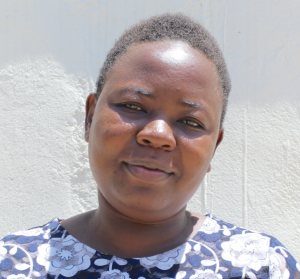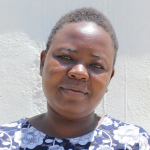"When I visit the hospital, the nurses are aware of my case even without me explaining to them; I have spent a lot of money treating typhoid. If I was to buy properties with the money I spent at the hospital, I would be the richest person in the community."
This is how Susan Awinja, a 50-year-old farmer and mother living in Lunyinya, described her relationship with Shirongo Spring. Serving 125 people in Lunyinya, Shirongo Spring is depended on as one of the only reliable year-round water sources here, yet it costs residents greatly in their health, time, and finances.
The community members tried protecting the spring some years back, but without the proper materials or technical expertise, they were not successful in a durable solution. Today, all that remains of their work is a pipe lodged in a small outcropping of cement and bricks. The catchment area is not protected, meaning the water is still contaminated. The access area is wet and slippery, forming a large puddle around the spring.
Community members of this particular spring have no specific time of day for drawing water. Instead, their water fetching schedules are more driven by the season. During holidays, most people try to draw water early in the morning or late in the evening because the children home from school lead to overcrowding. Because the community was not able to fully capture the spring's eyes in the catchment area, they are missing out on the spring's naturally high yield. This slows them down as they wait their turn to fetch water.
"During holidays, I wake up very early in the morning to go and draw water before other people just to avoid being part of the overcrowding team," said Phanice, a primary school-aged student.
Lacking a properly protected catchment area, the spring's water is still unsafe for consumption. Susan is not alone in falling ill after consuming the water. The community members said typhoid affects nearly all of the families that depend on this spring. Here, typhoid is particularly expensive to treat, as Susan noted. Medication and hospital visits lead to expensive medical bills and productive time lost for all ages.
The Lunyinya community is highly vegetated as a majority of the villagers practice mixed farming. Most buildings are semi-permanent in construction materials. Some farmers grow sugarcane to sell at the nearest factories. "The unity among the community members and respect given to their leaders is just amazing," noted Field Officer Betty.
What We Can Do:
Spring Protection
Protecting the spring will help provide access to cleaner and safer water and reduce the time people have to spend to fetch it. Construction will keep surface runoff and other contaminants out of the water. With the community’s high involvement in the process, there should be a good sense of responsibility and ownership for the new clean water source.
Fetching water is a task predominantly carried out by women and young girls. Protecting the spring and offering training and support will, therefore, help empower the female members of the community by freeing up more of their time and energy to engage and invest in income-generating activities and their education.
Training on Health, Hygiene, COVID-19, and More
To hold trainings during the pandemic, we work closely with both community leaders and the local government to approve small groups to attend training. We ask community leaders to invite a select yet representative group of people to attend training who will then act as ambassadors to the rest of the community to share what they learn. We also communicate our expectations of physical distancing and wearing masks for all who choose to attend.
The training will focus on improved hygiene, health, and sanitation habits in this community. We will also have a dedicated session on COVID-19 symptoms, transmission routes, and prevention best practices.
With the community’s input, we will identify key leverage points where they can alter their practices at the personal, household, and community levels to affect change. This training will help to ensure participants have the knowledge they need about healthy practices and their importance to make the most of their water point as soon as water is flowing.
Our team of facilitators will use a variety of methods to train community members. Some of these methods include participatory hygiene and sanitation transformation, asset-based community development, group discussions, handouts, and demonstrations at the spring.
One of the most important issues we plan to cover is the handling, storage, and treatment of water. Having a clean water source will be extremely helpful, but it is useless if water gets contaminated by the time it is consumed. We and the community strongly believe that all of these components will work together to improve living standards here, which will help to unlock the potential for these community members to live better, healthier lives.
We will then conduct a small series of follow-up trainings before transitioning to our regularly scheduled support visits throughout the year.
Training will result in the formation of a water user committee, elected by their peers, that will oversee the operations and maintenance of the spring. The committee will enforce proper behavior around the spring and delegate tasks that will help preserve the site, such as building a fence and digging proper drainage channels. The fence will keep out destructive animals and unwanted waste, and the drainage will keep the area’s mosquito population at a minimum.

 Protected Spring
Protected Spring
 Rehabilitation Project
Rehabilitation Project



































